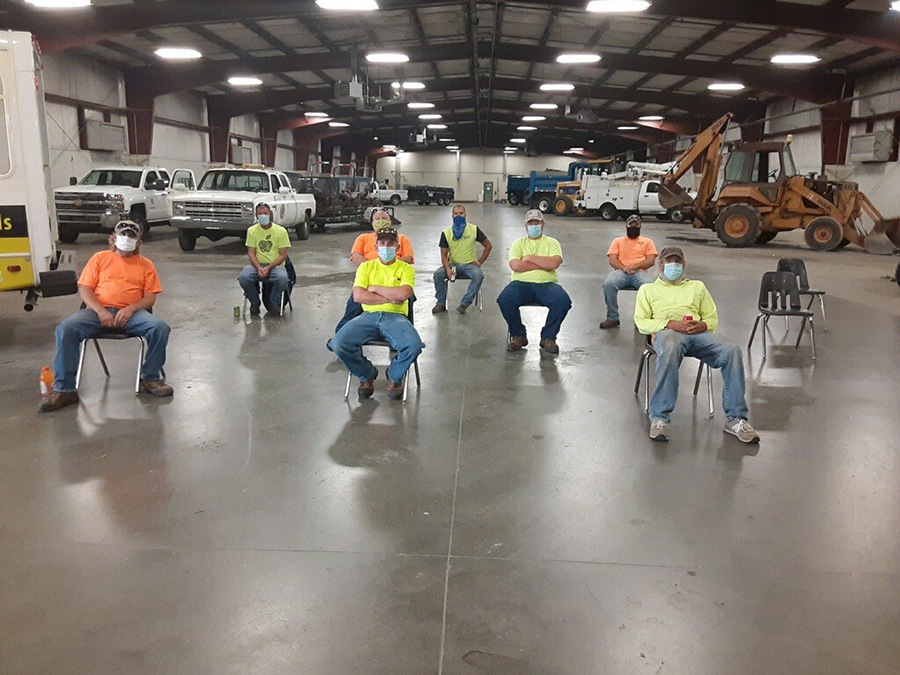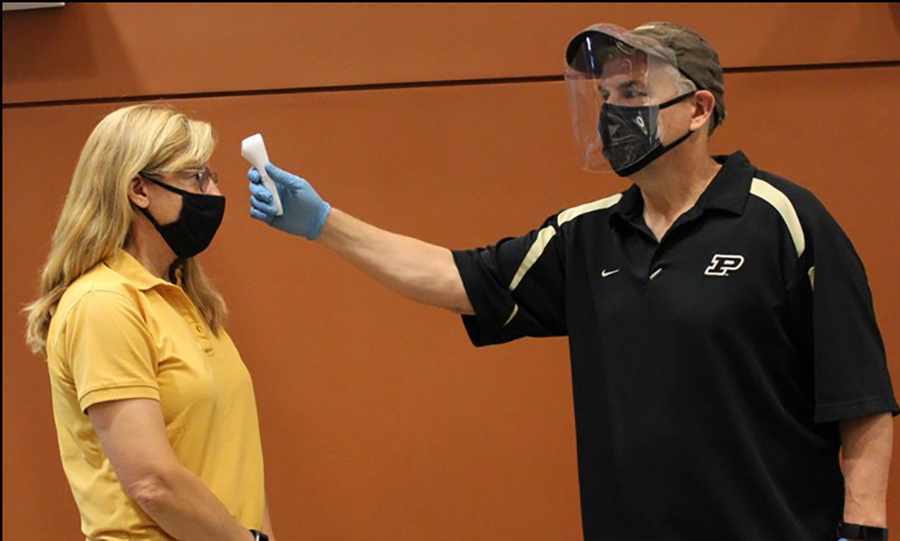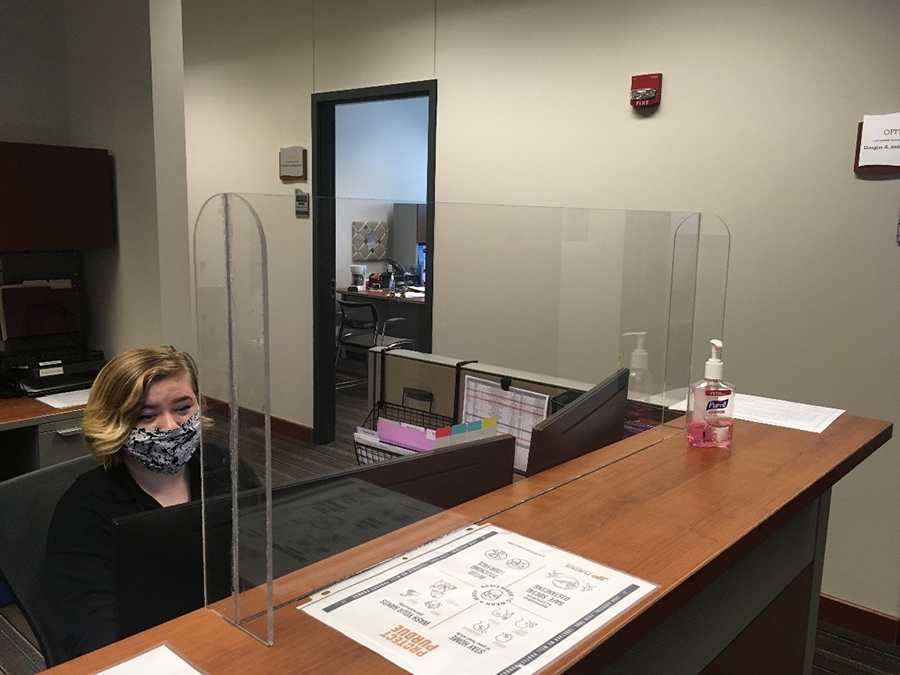Workplace Health and Safety – Call to Action
By Dr. Sarah Hubbard and Dr. Bryan Hubbard, Purdue University
It’s been more than six months since Governor Holcomb instituted Stage 1 procedures in response to Covid-19 and we have progressively opened back up, with Stage 5 beginning on September 26, and and the mask mandate extended on October 14.
While Indiana has made good progress to get Back on Track, it’s important that we all continue to take appropriate precautions to keep ourselves, our co-workers and our families safe, especially since fall and winter bring new risks due to flu and other seasonal contagious illness.
Below is a list of things you can do to help protect your team from infectious illnesses such as Covid-19 and the flu. Links to additional information are provided. Check with the LTAP Covid-19 resource page for additional resources as they are developed, and contact us (inltap@purdue.edu) if you have questions, comments or requests. Let’s Work Together to Stay Safe and Stay Healthy!
There are a number of things you can do to help prevent the spread of contagious illness in your department. Below is a checklist of topics to help get you started.
Vehicles and Equipment
- Assign each vehicle to a single driver or limited number of drivers.
- Limit vehicle occupancy.
- If ride sharing is necessary, keep windows open, use hand sanitizer before entering vehicle, wear cloth face covering while in vehicle, and sanitize commonly touched surfaces after each trip.
- Disinfect vehicles when changing drivers and at least once a shift. Watch LTAP video: Vehicle Sanitation Checklist.
- Disinfect equipment after every use when equipment is shared.
- Avoid sharing equipment
Manage the Team: Staffing Considerations
- Stagger work shifts to reduce congestion at the time clock and in shared areas.
- Use touch free clock-in/clock out stations if possible (some agencies have developed apps that allow clocking in via the a smart phone).
- Stagger break times to reduce the number of people in break rooms and other shared areas.
- Schedule small work crews and avoid rotating personnel to reduce interaction and the minimize the likelihood of spreading an illness.
- If you have workers that are in a high-risk group, consider giving them lower-risk jobs such as work they can do independently of others. You may want to work with Human Resources to develop a protocol that allows workers to self-identify risk factors while ensuring confidentiality of employee health information.
- Conduct briefings with smaller groups and maintain distance between workers.
- When weather permits, have meetings outside and use outdoor tables for breaks.
- Disinfect common areas regularly and after each crew has used the space.
- Encourage employees who can work
- Make sure each employee knows how they will receive work communication, and their points of contact for different work related issues.
- Create and share an agency contact list with primary and secondary contact information (e.g., email, office phone, and cell phone) as well as secondary contact people.
Daily Health Checks
- Daily temperature and symptom checks for employees.
- Consider if self-checks or workplace checks are most appropriate for your workplace.
Watch LTAP video: Employee Temperature and Symptom Checks. - Make sure all supervisors know the protocol that should be followed if an employee tests positive for Covid-19. Watch LTAP video: Employer Response to Positive Covid-19 Test.
Support Employee Health
- Encourage each employee to get their flu shot and other appropriate immunizations.
Identify sites where they can get a flu shot and allow them to do so during work hours - Educate employees to develop and maintain healthy habits, including regular medical check-ups, a well-balanced diet, exercise, and adequate rest. A holistic approach to employee health and safety, including daily symptom self-checks, may be part of a larger safety culture or human resource initiative.
- Share information about appropriate protocols with employees before they need it:
- What happens if I get sick?
- What happens if I am exposed to someone who is sick?
- When can I safely return to work?
- Appropriate protocols may vary for different agencies, and the nature of the work.
Reduce Health Risks Due to Facility Visitors
- Implement procedures for on-line, telephone, and curbside procedures to serve the public, whenever possible.
- Employ a screening policy for all people entering the facility (including the public, vendors, and other visitors).
- Share new policies via social media, the internet and posted signs.
- Rather than have people wait inside your facility, have them call from the parking lot, and wait in their car until your staff can call them when it is their turn.
- Use plexiglass shields or other appropriate physical barriers to protect receptionists and other staff members who interact with the public.
- If visitors are in your facility for 15-minutes or more, make sure you have their name and contact information.
- Implement a policy for the public and employees to wear face coverings in all public areas.
Manage Facilities
- Place hand sanitizing stations around your facilities and keep them stocked
- Implement regular and frequent disinfection of high touch areas (including doorknobs, handrails, time-clock station and other common surfaces). Watch LTAP video: Disinfection.
- Place sanitizing wipes around your facilities to encourage everyone to help with surface disinfection
- Transition drinking fountains to water bottle refill stations (and post appropriate signs)
- Prop open doors and install foot-pulls on doors to reduce the need for contact with shared surfaces
- Provide paper towels (and appropriate trash receptacles) and avoid use of hand dryers which may spread airborne germs.
- Reinforce new policies and support employee education with posters and signs that support safe practices.
Manage Facilities - Ventilation
- Increase ventilation with outside air by opening windows (weather permitting)
- For window air conditioners, ventilate with outside air
- Change your HVAC settings to maximize use of outside air and set the fan on continuous rather than automatic to increase air circulation
- Consider HEPA air-purifiers for spaces with poor ventilation
- Replace air filters regularly to ensure efficiency and effectiveness.
Develop a Plan and Follow the Plan
- Work with your local agency, human resources, and local health officials to develop a plan that is appropriate for your organization.
- Your plan should include the topics addressed in this checklist, as well as other information specific to your agency.
- Work with partner transportation agencies and nearby jurisdictions to develop Memorandums of Understanding for shared resources or collaborative activities that may be appropriate due to infectious illness or other emergency situations.
- Here is a link for the CDC Facility Assessment Checklist for Covid-19 Assessment and Control Plans. This provides a useful framework for reviewing your plan. This checklist was developed for manufacturing facilities, which have some similarities to street and highway departments and public works departments since they are also considered critical infrastructure employers.
Vehicles and Equipment
For team members that spend their time on local roads, the work truck may feel like a mobile office. Don’t let the familiarity of your vehicle allow you to let your guard down. Whenever possible, it’s best to avoid sharing vehicles. Ideally, a single operator is assigned to a single vehicle for the duration of the shift, and each vehicle is disinfected at the end of the shift. Practice good hand hygiene even if you are driving solo, and keep a bottle of hand sanitizer in the truck, and use it after you have been in public places.
When it is necessary to share a vehicle, have everyone sanitize their hands before entering the vehicle and after the trip, and sanitize frequently touched surfaces such as the door handles, grab bars, steering wheel, gear shift and other controls. When riding in a shared vehicle, limit occupancy, wear a cloth face covering, and open the windows and turn on the fan with outside air to provide as much ventilation with fresh air as possible.
If you share tools with others, make sure you don’t also share germs. Disinfect handles and other high touch surfaces at the end of each shift or whenever you return the tool for common use.
For more information, take a look at the LTAP Video: Vehicle Sanitation Checklist Video.
Manage the Team: Staffing Considerations
Team work is important to get the job done and careful planning of activities can ensure that you limit the exposure of each team member to infectious illnesses. Smaller work crews, staggered work shifts, and stability in team assignments can all help reduce the number of people that each employee interacts with.
It may be appropriate to conduct briefings with smaller groups or hold meetings outside or in other locations where there is plenty of room for everyone to keep their distance.
Take a look at this LTAP Case Study to see how one local agency increased productivity by implementing remote clock-in capabilities that allows workers to go directly to their first field location rather than stopping by the garage to physically clock-in.

Daily Health Checks
Daily health checks include temperature checks and symptom checks. Some local agencies have implemented daily temperature checks and/or employee self-assessment via smart phone app. Other local agencies have employees and visitors conduct self-assessment before entering the facility.
In any case, it’s important to make sure your employees and visitors are educated regarding the symptoms they should assess. For Covid-19, the symptoms have changed over time as we learn more. Per the CDC, people with COVID-19 may have no symptoms, or may have a wide range of symptoms that may be mild or severe. Symptoms may appear 2-14 days after exposure to the virus. People with these symptoms may have COVID-19[1]:
- Fever or chills,
- Cough,
- Shortness of breath or difficulty breathing,
- Fatigue,
- Muscle or body aches,
- Headache,
- New loss of taste or smell,
- Sore throat,
- Congestion or runny nose,
- Nausea or vomiting,
- Diarrhea.
These symptoms may also be associated with the flu, other illnesses, or allergies. Typically, if an employee has an elevated temperature or other symptoms, they should not enter the facility, and should return home and contact a health care provider. For more information, Watch LTAP video: Employee Temperature and Symptom Checks.

Support Employee Health
Healthy habits can help employees stay healthy, and also may reduce illness complications, which are more likely if there are existing health risks (sometimes called co-morbidities). Educating and encouraging employees to adopt healthy lifestyles may include educational campaigns about annual vaccinations (for the flu and other illnesses) and regular medical check-ups, as well as the importance of nutrition, exercise and adequate rest. Check with your human resources department or local health agency for supporting information or programs so you can leverage existing materials and support efforts that may already be underway.
Make sure employees know the protocol they should follow if they experience symptoms of illness or are exposed to someone who has an infectious illness. Realize that the protocol for people who conduct essential work (including public works and essential infrastructure, which includes local roads) may be different than for other local agency employees. It’s also helpful for employees to know when it is safe to return to work, not only for themselves, but so they are comfortable working around other employees who are returning to work.
For more information, Watch LTAP video: Employer Response to Positive Covid-19 Test.
Reduce Health Risks Due to Facility Visitors
Serving the public is a key component of local road, street and public works agencies. Many local agencies have transitioned services and communication on-line and via telephone to ensure the communication can continue, without the need for face-to-face interaction. If you do allow visitors in your facility, consider screening visitors (or requesting they self-screen), limiting the number of visitors allowed at one time, having visitors wait in the parking lot for their turn, and other practices that reduce the likelihood of exposure, both for visitors and your employees.

Manage Facilities
Since Covid-19 and many infectious illnesses are spread through personal contact and proximity, it is important to implement best practices to reduce the likelihood of transmission within the workplace. Make sure appropriate supplies are widely available, including hand sanitation stations and surface sanitation stations. Not only do these stations encourage everyone to help, but they also provide visible reminders regarding the need for good hygiene.
For more information, Watch LTAP video: Disinfecting the Workplace.
Best practices may include minor facility modifications and changes in protocol. Minor modifications, such as propping doors open and installing foot pulls on doors, can also reduce the need for common touch surfaces. In some cases, protocol may require informational signs rather than expensive physical modification. For example, post signs to remind employees that water fountains should be used for water bottles only, and to leave windows open in the garage to support increased ventilation and air flow.
Manage Facilities - Ventilation
Since Covid-19 and other contagious illnesses may spread through small airborne particles, HVAC systems may be another tool to support workplace safety. Increase the air flow exchange rate and make sure filters are HEPA, if compatible with the system. Although it may not be practical to make changes to the building HVAC system, it is possible to increase indoor air quality by using standalone HEPA air filtration units.
Develop a Plan and Follow the Plan
There are a lot of considerations for a local agency when dealing with an infectious illness outbreak. Developing even a basic plan can help you prepare for operations during an infectious illness, and you may find that some components of the plan are also useful during other circumstances that result in irregular operations and other emergencies.
It may be helpful to work with your local agency, human resources, local health officials, and partner transportation agencies for different components of the plan. The collaboration and partnership that results may be helpful for other situations, as well.
This Facility Assessment Checklist for Covid-19 Assessment and Control Plans was created by CDC and may be used to develop or review your facility plan. This checklist was developed for manufacturing facilities, which are similar to street and highway departments in that they are considered Non-healthcare Critical Infrastructure Employers[2]. ().
[1] This list was retrieved October 14, 2020 from https://www.cdc.gov/coronavirus/2019-ncov/symptoms-testing/symptoms.html Check the CDC website to confirm the current list of symptoms.
[2] This was retrieved on October 11, 2020 from https://www.cdc.gov/coronavirus/2019-ncov/community/guidance-manufacturing-workers-employers.html#create-assessment-plan. Check the CDC website for updated versions of this information.
- Digital Newsletters
- Vol 38 No 1.1
- Vol 38 No 1.2
- Vol 38 No 1.3
- Vol 38 No 2.1
- Vol 38 No 2.2
- Vol 39 No 1.1